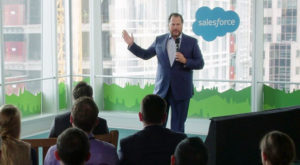Corporate executives know that if they don’t transform their companies into digital enterprises, they are going to be at a significant competitive disadvantage going forward. Yet, many corporate leaders have been unable to make significant progress in transforming their organizations. Many executives have found that changing their corporate cultures is a lot harder than adopting the new generation of cloud-based applications and services that make the digital enterprise possible.
No company has done more to advocate for this digital transformation process — so it can sell more of the cloud solutions to power new-age businesses — than Salesforce. And no company is more at risk if a growing number of organizations fail to pursue their own digital transformation initiatives.
For the past decade, Salesforce has become a market leader not only by offering a more user-friendly CRM solution via a software-as-a-service model but also by painting a clear picture for CXOs about the tangible business benefits of a more connected, go-to-market strategy that capitalizes on e-commerce, mobile and social channels via the cloud.
Now, Salesforce is shifting its attention dramatically — away from solely selling CXOs on the virtues of leading the digitization process and toward showing how everyday employees can make the transformation process a reality.
My Oh My
This shift was clearly on display at this year’s Dreamforce conference, Salesforce’s annual lovefest in San Francisco. Salesforce has taken a two-pronged approach to accelerating the digital transformation process and bolstering its sales growth to continue to defy the “law of large numbers.”
First, Salesforce has made its applications and developer tools easier to use in the hope of attracting more companies and programmers to its products and services. Second, Salesforce has invested heavily in a vibrant new training program called “Trailhead” to increase exponentially the population of citizen programmers who can capitalize on its software capabilities.
Salesforce’s major product announcements at Dreamforce centered around the company’s new generation of more personalized solution-building capabilities. Salesforce promised to make its current offerings more user-friendly, with simpler graphical interfaces and fewer software coding requirements.
The company unveiled new “my” branding across many of its key product areas to emphasize the increasing ease of use and customization capabilities of Salesforce’s offerings.
For example, mySalesforce and myLightning promise to help users create their own custom-branded mobile and productivity apps. MyEinstein, an attempt at demystifying the idea of artificial intelligence, allows users to build AI-powered apps. MyIoT is designed to speed the creation and testing of connected products and services.
In each of these cases, Salesforce’s aim is to encourage faster and broader adoption through simpler products and tools.
Gamification Strategy
Although the conference sessions describing these new offerings and the vendor expo promoting the latest products were heavily trafficked, the epicenter of energy during Dreamforce was inside the Moscone West building, the headquarters of the company’s Trailhead training program.
Salesforce launched Trailhead at the 2014 Dreamforce as a bold, new approach to filling the gap created by the growing demand for software developers and data scientists. Rather than rely on the uninspiring training techniques of the past to fill the void, Trailhead has leveraged online delivery systems, peer-to-peer oriented instruction, and the latest gamification methods to make the learning process fun and empowering.
As always, Salesforce spared no expense to create a Disneyland-like environment for its Trailhead pavilion in the Moscone West building, populated with an assortment of animated characters that would have made Walt Disney envious. There were long lines of attendees hoping to acquire and even willing to buy Trailhead logoed tee shirts, hats, sweatshirts, and dolls.
However, it was the Trailhead buttons signifying various training achievements and certifications that generated the most buzz and demonstrated how powerful the Trailhead gamification strategy has become.
In an era in which many people feel threatened by the advent of the ‘Fourth Industrial Age’ of AI and machine learning, Salesforce has created an antidote that offers a cross-section of current employees and young people just entering the work world new hope that they can chart their own path to success in a rapidly changing marketplace.
Bottom Up
Turning typical employees into digital transformers is not only a way to ease the angst of corporate end-users. It is also a clever tactic to circumvent the logjam that has plagued corporate executive suites that have become paralyzed with the daunting task of implementing enterprise-wide digital strategies.
Rather than wait for their corporate leaders to convert their digital visions into elaborate business plans, Salesforce has encouraged company end-users to take their own initiative and use its cloud solutions to improve their day-to-day business processes along with the quality of their products and services. It also has built a robust new revenue stream via training programs for corporate end users, developers, and partners.
In the past, each Dreamforce keynote presentation congratulated corporate executives for being visionary leaders. To really bring Salesforce’s new ‘trailblazer’ message to the forefront, it made sure that every new product keynote presentation at this year’s conference showcased a corporate end-user who leveraged Salesforce’s capabilities to make a difference.
This tactic created a different kind of energy. Rather than suggest that digital transformation can only succeed from the top down, with a rare breed of visionary executives leading the charge, Salesforce has conveyed a message that anyone can make change happen from the bottom up, turning once faceless end-users into digital heroes.
Putting end-users on a pedestal makes them proud to become advocates on behalf of Salesforce’s products and benefits.
This new go-to-market strategy will encourage more adoption of Salesforce’s products, attract more developers to its ecosystem, and fuel the continued growth of its revenues and profits.
Disclosure: Salesforce.com paid my airline and hotel expenses to enable me to attend the event but did not commission this column or any other analysis from THINKstrategies, Inc.























































Social Media
See all Social Media